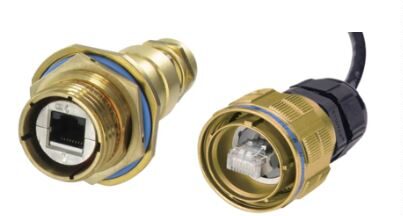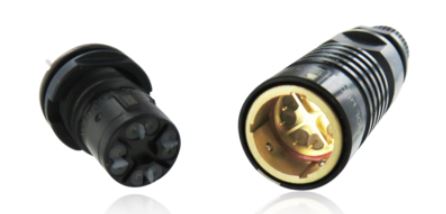Five Military Trends Paving the Way for Harsh Environment Connectivity
The military requires connectors that are as small, fast, and lightweight as possible while being durable and secure. Learn more about products that fit the bill.

Military trends require connectors that are as small, fast, and lightweight as possible while being durable and secure. Even in the harshest environments, modern military electronics must take up less space yet reach the highest speeds the industry can offer. Therefore, the connectors used on military equipment must excel under these five conditions: durability, size, speed, cybersecurity, and versatility.

Cat6A RJFTV: Amphenol Socapex RJF/ RJFTV allows you to use an Ethernet Category 5E/6/6A connection for 10 BaseT, 100 BaseTx, 1000 BaseT or 10G BaseT networks in harsh environments. With the patented RJStop system you can use a standard RJ45 cordset in a metallic plug which will protect it from shocks, dust, and fluids. No hazardous on-field cabling and grounding!
Durability
Rugged connectors or interconnect systems are specifically designed to be reliable in harsh environments with conditions such as strong vibration, extreme temperature, moisture, and dust. They need to withstand high altitudes, shock, humidity, and harsh sealing requirements. Military trends are moving towards harsh environment use, so interconnects must be designed to survive the different challenging military environments, including air, land, sea, and space. Rugged connectors need to be manufactured using the highest standards with a focus on strength, safety, and efficiency while maintaining a high level of quality. It is vital that these products perform reliably when needed in the field. The external housing and connections are not the only parts that must handle these conditions. The internal components of the equipment and the connector itself need to be rugged as well. Both the external housing and internal components are rigorously tested and qualified to ensure that they can handle any environment that soldiers or their equipment may encounter.
Size & speed
Reduced size and weight is a key military trend. Paired with the ever-increasing demand for faster data exchange rates in telecommunication networks, this has driven the demand for high-speed electronics and passive components. As a result, system designers face extensive challenges, most notably in the preservation of high-speed signal integrity through system stacks. To maximize communication speeds, the design of high-speed systems requires technology offering the greatest data rate for each architecture level (boards, contacts, connectors, and cables).

uCom: Amphenol Socapex µCom series is a new range of connectors designed to address the latest trends of the industry: miniaturization and high speed, with the highest resistance for use in the harshest environments. µCom has a maximum 15 mm external diameter and is also offered as TVµCom, where it is inserted in a size 11 MIL-DTL-38999 series 3 shell.
Cybersecurity
Just as companies need to protect their data from hackers looking to steal information, the military needs to protect its network against cyberattacks from enemies. Cybersecurity is achieved through a combination of physical precautions, software solutions, and password strategies. The military must take precise steps to ensure its network is secure.
Providing proprietary interfaces to connectors that differ from the standard commercial interfaces helps make the military network more secure. The µCom, which is offered for both Cat 6A/Cat 7 Ethernet and USB 3.0 signals uses an interface that differs from the standard commercial interface and adds another layer of security which decreases the risk of an enemy hacking into the system. Commonly used standard USB-A or RJ45 ports make it much easier for the enemy to hack. Utilizing locking devices reduces the risk of intrusion into the electronics through the connectors.

PlugLock and CapLock Amphenol Socapex is the first to manufacture plug and receptacle caps that lock in place for MIL-DTL-38999 style connectors. CapLock and PlugLock add yet another level of security and will only unlock with specifically designed tools.
Versatility
Military trends favor versatile connectors. The USB-C interface is expected to become popular in military equipment as a new generation of devices come into use. USB-C has a very small interface, achieves a high data rate, and can be inserted into a military connector shell. Compared to the USB-A interface, USB-C, a high-speed connector, is much more compact and comparable in size to micro-USB connectors. The new USB-C cables double the data transfer rate that traditional USB cables can achieve, increasing the data rate from 5 Gb/s to 10 Gb/s.
USB-C cables can handle significantly more power than traditional USB cables, which are limited to 5 watts. USB-C cables improve the power capability to 25 watts. The military is quickly adapting to USB-C for applications, especially as USB-C ports are already found in the latest laptops and phones.
Ultimately, durability, size, cybersecurity, and versatility are five military trends that will pave the way for the future of harsh environment connectivity. Reducing size and weight in military equipment, combined with the increasing demand for faster data exchange rates in telecommunications, is essential on the battlefield and in military installations. In addition, cybersecurity is crucial for protecting military networks from enemy attacks. Finally, the military needs versatile connectors. Connecters such as the new USB-C, with its small interface, high data rate, and easy insertion into a military connector shell, are ideal. Small form factor rugged connectors that can withstand harsh environments, and are high-speed and lightweight, will enable more effective military equipment designs in the years to come.
Visit Amphenol PCD to learn more.
Like this article? Check out our other Technology Trends, Mil/Aero Market articles, and our 2023 Article Archives.
Subscribe to our weekly e-newsletters, follow us on LinkedIn, Twitter, and Facebook, and check out our eBook archives for more applicable, expert-informed connectivity content.
- Five Military Trends Paving the Way for Harsh Environment Connectivity - November 7, 2023





